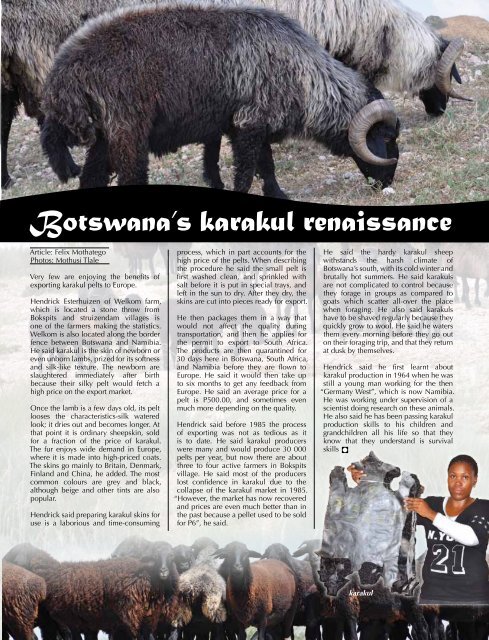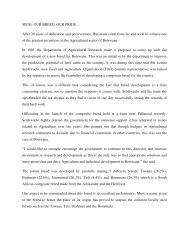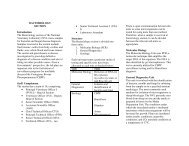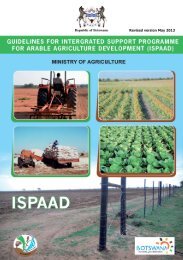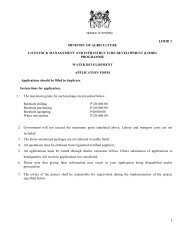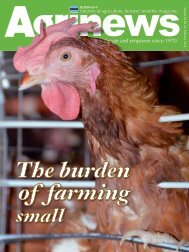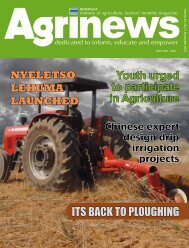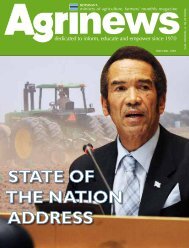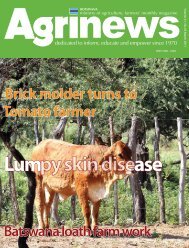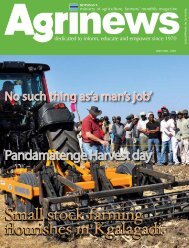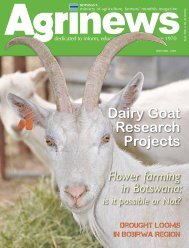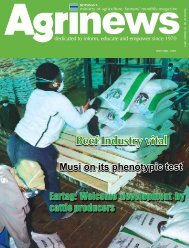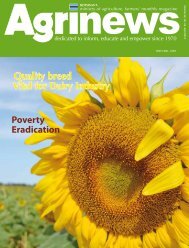Botswana's karakul renaissance - Ministry of Agriculture
Botswana's karakul renaissance - Ministry of Agriculture
Botswana's karakul renaissance - Ministry of Agriculture
Create successful ePaper yourself
Turn your PDF publications into a flip-book with our unique Google optimized e-Paper software.
Botswana’s <strong>karakul</strong> <strong>renaissance</strong><br />
Article: Felix Mothatego<br />
Photos: Mothusi Tlale<br />
Very few are enjoying the benefits <strong>of</strong><br />
exporting <strong>karakul</strong> pelts to Europe.<br />
Hendrick Esterhuizen <strong>of</strong> Welkom farm,<br />
which is located a stone throw from<br />
Bokspits and struizendam villages is<br />
one <strong>of</strong> the farmers making the statistics.<br />
Welkom is also located along the border<br />
fence between Botswana and Namibia.<br />
He said <strong>karakul</strong> is the skin <strong>of</strong> newborn or<br />
even unborn lambs, prized for its s<strong>of</strong>tness<br />
and silk-like texture. The newborn are<br />
slaughtered immediately after birth<br />
because their silky pelt would fetch a<br />
high price on the export market.<br />
Once the lamb is a few days old, its pelt<br />
looses the characteristics-silk watered<br />
look; it dries out and becomes longer. At<br />
that point it is ordinary sheepskin, sold<br />
for a fraction <strong>of</strong> the price <strong>of</strong> <strong>karakul</strong>.<br />
The fur enjoys wide demand in Europe,<br />
where it is made into high-priced coats.<br />
The skins go mainly to Britain, Denmark,<br />
Finland and China, he added. The most<br />
common colours are grey and black,<br />
although beige and other tints are also<br />
popular.<br />
Hendrick said preparing <strong>karakul</strong> skins for<br />
use is a laborious and time-consuming<br />
process, which in part accounts for the<br />
high price <strong>of</strong> the pelts. When describing<br />
the procedure he said the small pelt is<br />
first washed clean, and sprinkled with<br />
salt before it is put in special trays, and<br />
left in the sun to dry. After they dry, the<br />
skins are cut into pieces ready for export.<br />
He then packages them in a way that<br />
would not affect the quality during<br />
transportation, and then he applies for<br />
the permit to export to South Africa.<br />
The products are then quarantined for<br />
30 days here in Botswana, South Africa,<br />
and Namibia before they are flown to<br />
Europe. He said it would then take up<br />
to six months to get any feedback from<br />
Europe. He said an average price for a<br />
pelt is P500.00, and sometimes even<br />
much more depending on the quality.<br />
Hendrick said before 1985 the process<br />
<strong>of</strong> exporting was not as tedious as it<br />
is to date. He said <strong>karakul</strong> producers<br />
were many and would produce 30 000<br />
pelts per year, but now there are about<br />
three to four active farmers in Bokspits<br />
village. He said most <strong>of</strong> the producers<br />
lost confidence in <strong>karakul</strong> due to the<br />
collapse <strong>of</strong> the <strong>karakul</strong> market in 1985.<br />
“However, the market has now recovered<br />
and prices are even much better than in<br />
the past because a pellet used to be sold<br />
for P6”, he said.<br />
He said the hardy <strong>karakul</strong> sheep<br />
withstands the harsh climate <strong>of</strong><br />
Botswana’s south, with its cold winter and<br />
brutally hot summers. He said <strong>karakul</strong>s<br />
are not complicated to control because<br />
they forage in groups as compared to<br />
goats which scatter all-over the place<br />
when foraging. He also said <strong>karakul</strong>s<br />
have to be shaved regularly because they<br />
quickly grow to wool. He said he waters<br />
them every morning before they go out<br />
on their foraging trip, and that they return<br />
at dusk by themselves.<br />
Hendrick said he first learnt about<br />
<strong>karakul</strong> production in 1964 when he was<br />
still a young man working for the then<br />
“Germany West”, which is now Namibia.<br />
He was working under supervision <strong>of</strong> a<br />
scientist doing research on these animals.<br />
He also said he has been passing <strong>karakul</strong><br />
production skills to his children and<br />
grandchildren all his life so that they<br />
know that they understand is survival<br />
skills<br />
<strong>karakul</strong><br />
May 2010


